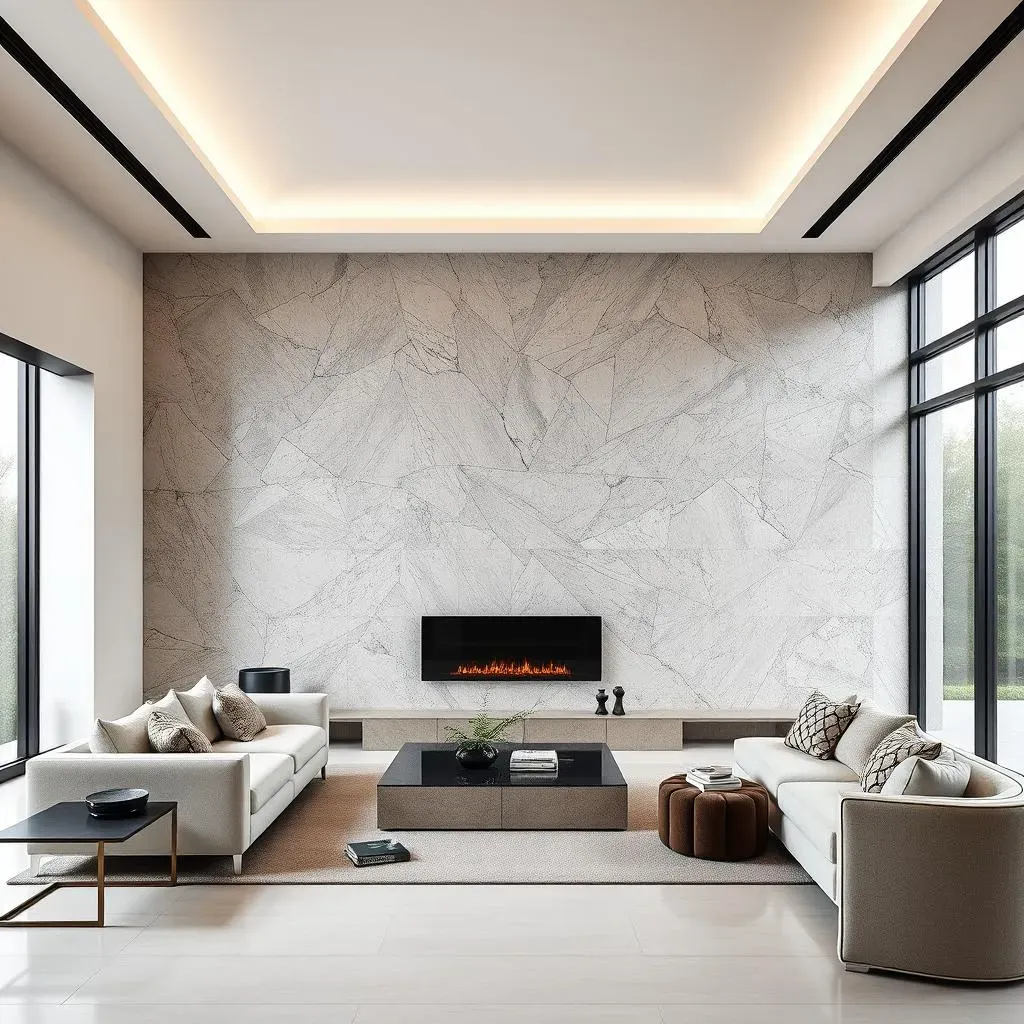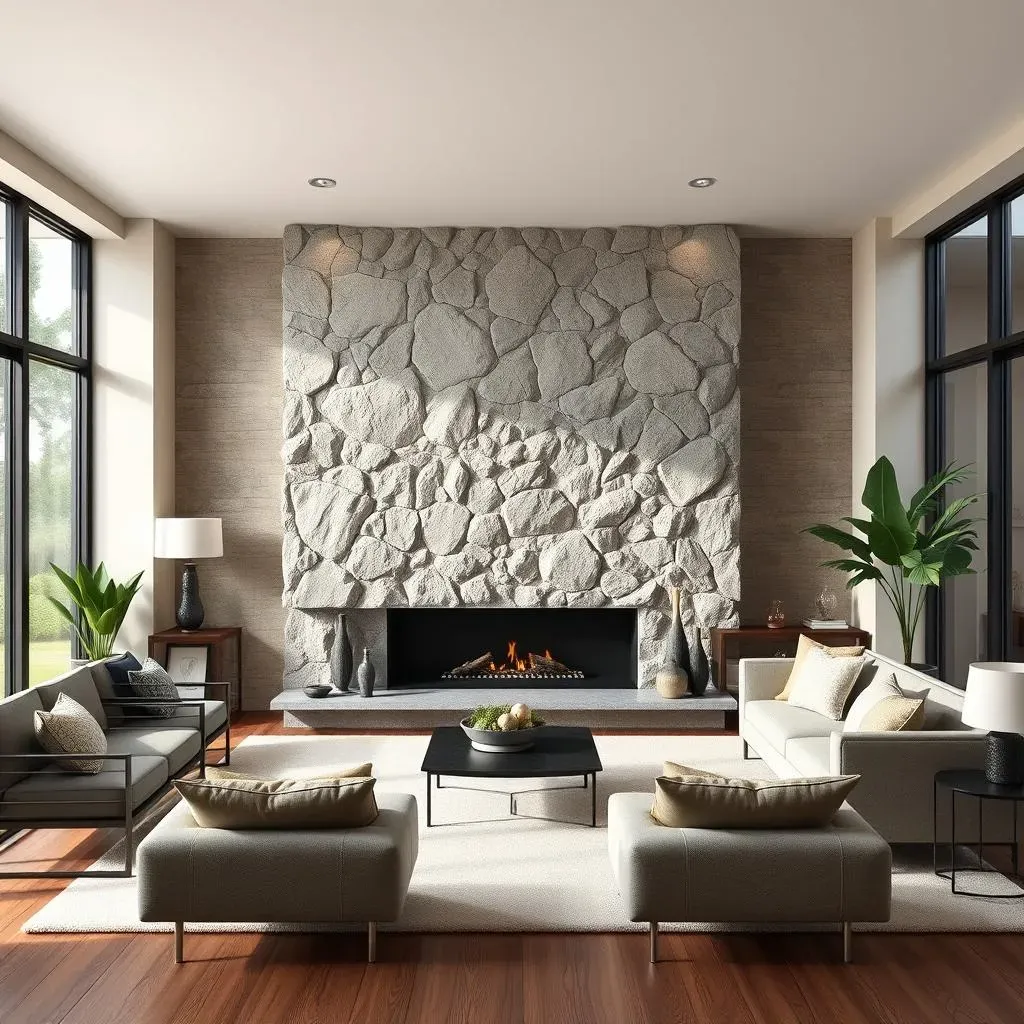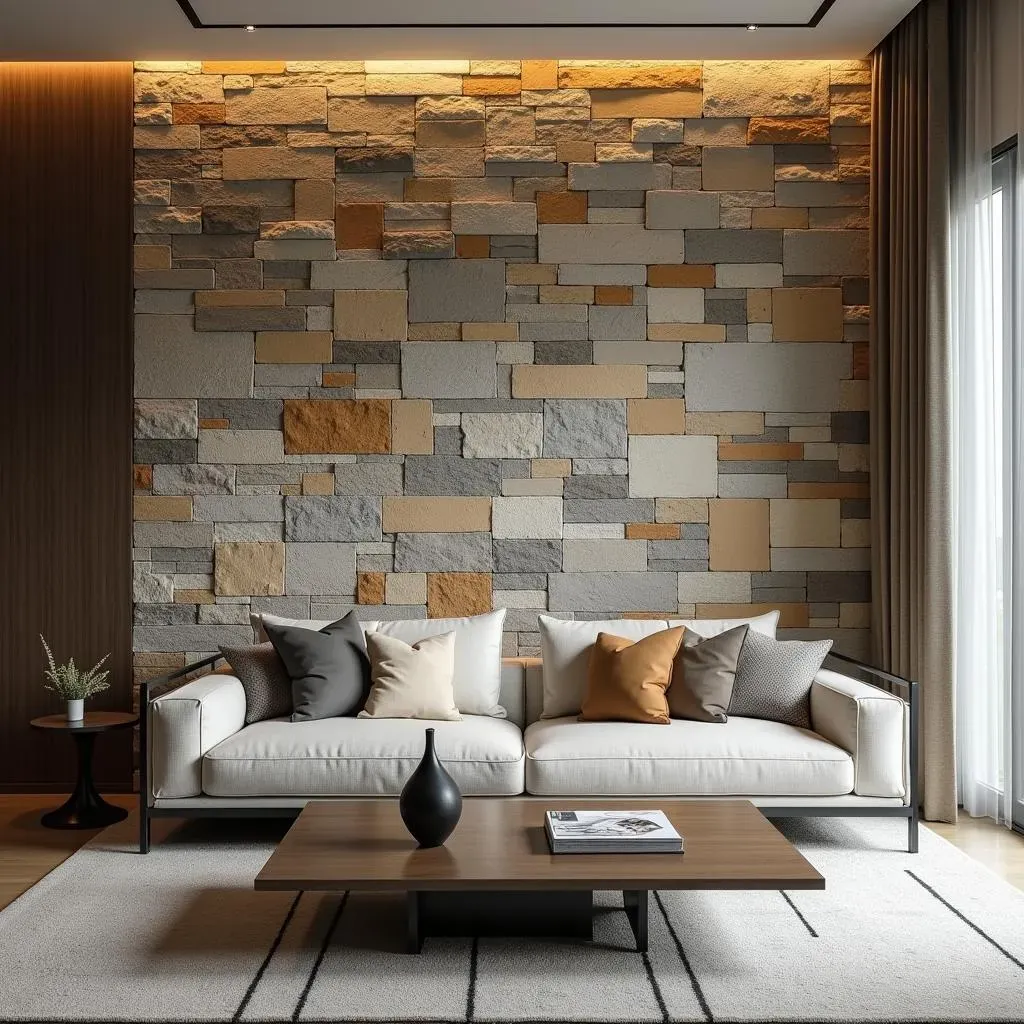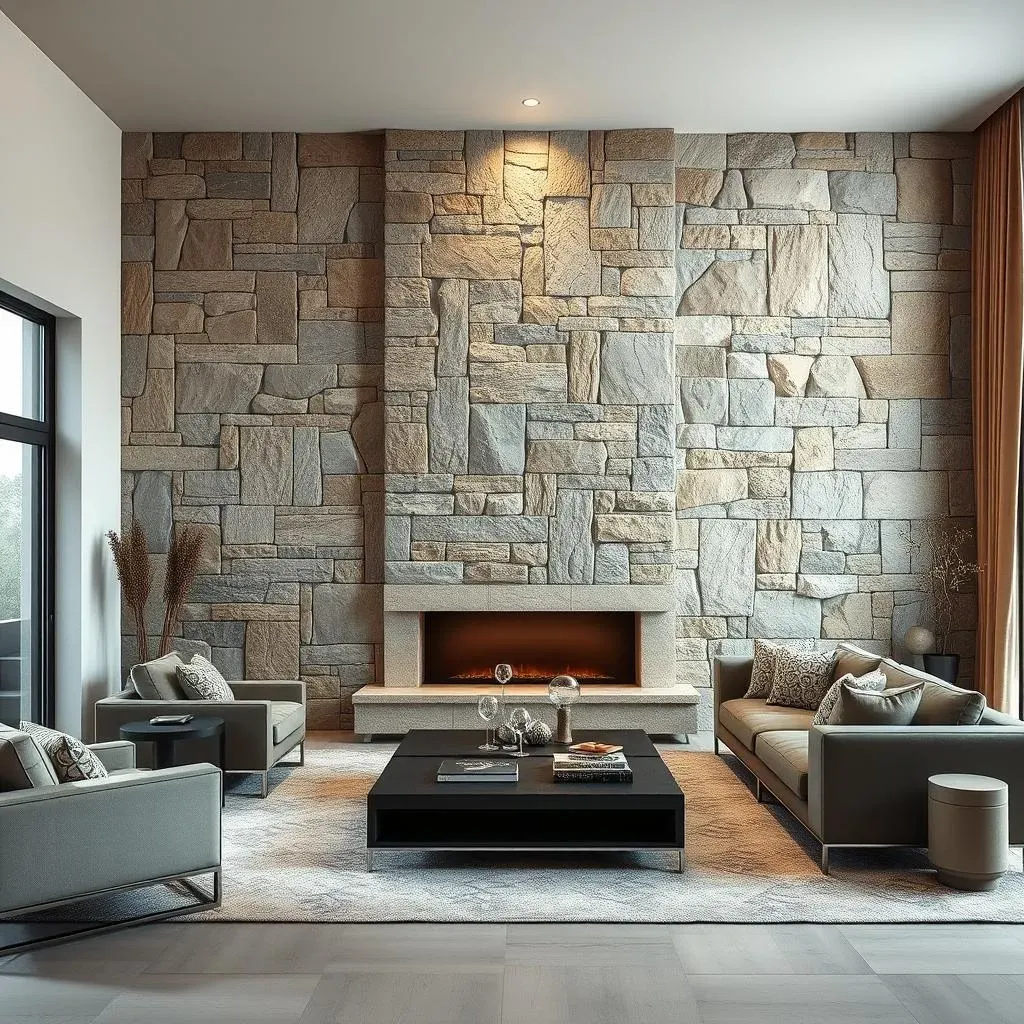Table of Contents
Ready to give your living room a dramatic makeover? Forget boring paint – let's talk stone! This article is your ultimate guide to "living room accent wall ideas with stone," transforming a simple wall into a stunning focal point. We'll explore the diverse world of stone options, from rustic to modern, helping you choose the perfect material to match your style. Then, we'll dive into design considerations: where to place your accent wall for maximum impact, how to choose colors and textures that complement your existing décor, and even how to incorporate the stone wall into your overall living room design. Finally, we'll tackle the practical aspects of installation and maintenance, guiding you through the process whether you're a DIY enthusiast or prefer to hire a professional. Get ready to be inspired and discover the incredible transformation a stone accent wall can bring to your living space! Prepare to be amazed by the possibilities, from sleek modern designs to cozy rustic retreats. Let's create the living room of your dreams, one stone at a time.
Choosing the Perfect Stone for Your Living Room Accent Wall

Choosing the Perfect Stone for Your Living Room Accent Wall
Natural Stone vs. Faux Stone: Making the Right Choice
So, you're ready to add a stone accent wall to your living room? Fantastic! But first, a big decision: natural stone or faux stone? Natural stone, like granite or slate, brings undeniable luxury and a touch of the outdoors in. It's durable and long-lasting, but it comes with a higher price tag and can be heavier, requiring more structural support. Think of it like choosing between a vintage sports car and a new, reliable sedan; both get you where you're going, but with very different styles and costs. For a truly unique look, consider the natural variations in color and texture – no two pieces are exactly alike!
Faux stone, on the other hand, offers a more budget-friendly and lightweight alternative. It cleverly mimics the look of natural stone, often with impressive accuracy. Installation is generally easier, and it's a great option if you're working with a smaller space or have concerns about structural load. Plus, faux stone comes in a wider variety of colors and finishes, giving you more creative freedom. If you’re aiming for a specific look, or are working with a smaller budget, this might be the better option for you.
Feature | Natural Stone | Faux Stone |
|---|---|---|
Cost | High | Low |
Weight | Heavy | Light |
Durability | Excellent | Good |
Installation | More complex | Easier |
Exploring Different Stone Types and Their Aesthetics
Once you've decided between natural and faux stone, it's time to explore the many types available. Each stone offers a unique aesthetic, impacting the overall feel of your living room. Think about your existing décor: a modern living room might pair beautifully with sleek quartz or polished marble, while a rustic space could embrace the warmth of stacked stone or the rugged charm of river rock. Remember, the stone should enhance your existing style, not clash with it. For example, a clean, minimalist living room might benefit from a modern accent wall, while a more traditional space might be better served by something more textured.
Consider the color palette of your room, too. Darker stones can create a dramatic and sophisticated atmosphere, while lighter stones can brighten and open up a space. Do you want a bold statement or a subtle accent? Perhaps you could even incorporate different stone types within the same wall for a layered effect. The possibilities are endless! For instance, you might use a lighter stone around a fireplace and a darker stone on the remaining wall to create visual interest. If you are working with a small living room, consider using lighter colors to avoid making the room feel smaller. Check out our ideas for small living rooms.
- Granite: Durable, luxurious, and comes in a wide range of colors.
- Marble: Elegant, classic, and known for its veining.
- Slate: Rustic, textured, and available in various shades of gray and black.
- Limestone: Soft, subtle, and perfect for a more understated look.
Considering Practical Factors: Maintenance and Durability
Beyond aesthetics, think practically! How much maintenance are you willing to commit to? Natural stone often requires sealing to protect against stains and damage. Some stones are more porous than others, meaning they absorb liquids more easily. Faux stone, on the other hand, is generally easier to clean and maintain, often requiring only regular dusting or wiping. This is a crucial point to consider, particularly if you have young children or pets who might make a mess! It's all about balancing your lifestyle with your design aspirations.
Finally, consider the durability of your chosen stone. Will it withstand daily wear and tear? If you have pets that scratch or children who like to play near walls, a more durable option might be necessary. Research different stone types' hardness and scratch resistance before making your final decision. Ultimately, choosing the perfect stone is a balancing act between aesthetics, practicality, and budget. Don't rush the process – take your time to explore your options and find the perfect stone to transform your living room. Consider the overall style of your living room and choose a stone that complements it. For example, a rustic living room might pair well with a stacked stone accent wall, while a modern living room might look better with a sleek, polished stone.
Designing Your Dream Living Room with a Stone Accent Wall: Style and Placement

Designing Your Dream Living Room with a Stone Accent Wall: Style and Placement
Choosing the Right Wall: Placement and Proportion
Now that you've picked your perfect stone, let's talk placement! Where you put that stunning accent wall dramatically affects the whole room's vibe. A fireplace wall is a classic choice – it's a natural focal point, and the stone adds warmth and texture. But don't limit yourself! A wall behind a sofa creates a cozy reading nook, and a wall opposite the windows can add visual interest and balance. Think about the flow of your living room and where your eye naturally goes. You want your stone wall to enhance, not disrupt, that natural flow.
Consider the size of your wall, too. A small wall might be overwhelmed by a large, bold stone design. Conversely, a massive wall might look sparse with a small, delicate stone feature. Proportion is key! A good rule of thumb is to have the accent wall take up roughly 1/3 to 1/2 of the overall wall space in the room. If you're unsure, sketching out your ideas or using online design tools can be incredibly helpful. For inspiration on finding the perfect spot for your accent wall, check out these modern living room ideas.
Wall Location | Pros | Cons |
|---|---|---|
Fireplace Wall | Natural focal point, adds warmth | May require more complex installation |
Behind Sofa | Creates cozy seating area | May limit furniture placement |
Opposite Windows | Balances light, adds visual interest | May compete with window views |
Style and Texture: Harmonizing with Your Decor
Once you’ve decided on placement, it’s time to think about style and texture. Does your living room lean towards modern minimalism, rustic charm, or something in between? Your stone choice should complement your existing décor, not fight it. Think about the colors, patterns, and textures already present. A modern living room might pair well with a smooth, polished stone in neutral tones, while a rustic space might thrive with a textured, stacked stone wall. A wallpapered accent wall could also complement your stone wall.
Don't be afraid to experiment with texture! A rough, uneven stone can add visual interest and depth, while a smooth, polished stone can create a sleek and sophisticated look. Consider the overall feel you want to create: cozy and inviting, dramatic and bold, or serene and calming. The texture of your stone will play a significant role in achieving the desired ambiance. You can also play with different lighting options to highlight the texture of your stone wall. For example, you can use recessed lighting or spotlights to create a dramatic effect or use soft, ambient lighting to create a warm and inviting atmosphere. For more inspiration on creating a cohesive living room design, check out these paint color ideas to complement your stone wall.
- Modern Minimalist: Sleek, polished stone in neutral tones.
- Rustic Charm: Textured, stacked stone in warm earth tones.
- Transitional Style: A blend of smooth and textured stones.
Lighting and Accessories: Adding the Finishing Touches
Finally, don't forget the finishing touches! Lighting can dramatically impact the look and feel of your stone accent wall. Recessed lighting can highlight the stone's texture, while strategically placed spotlights can create dramatic shadows and depth. Consider using sconces or other wall-mounted fixtures to add ambiance and visual interest. Remember, good lighting is key to showcasing your new stone wall. And don't overlook the power of accessories! Artwork, mirrors, or shelves can add personality and further enhance the wall's design.
Think about how you want to use the space around your stone wall. Will it be a focal point, a backdrop for furniture, or a combination of both? This will influence your choice of accessories. For instance, a large mirror placed above a fireplace can reflect light and make the room feel more spacious. Floating shelves can display treasured items, adding personality and warmth to the space. Remember, your stone accent wall is a canvas for your creativity. Let your personality shine through, and have fun decorating! For more ideas on incorporating other elements into your living room design, check out these ideas for living rooms with TVs.
DIY or Pro? Installation and Maintenance Tips for Your Living Room Stone Accent Wall

DIY or Pro? Installation and Maintenance Tips for Your Living Room Stone Accent Wall
DIY vs. Professional Installation: Weighing Your Options
So, you've chosen your stunning stone and planned the perfect placement. Now comes the big question: DIY or hire a pro? Installing a stone accent wall isn't a weekend project; it requires precision and, for natural stone, some serious muscle. If you're handy with tools and enjoy a challenge, a DIY approach might be rewarding. However, natural stone is heavy and requires precise cutting and placement to avoid cracks or damage. If you're aiming for a perfect, professional finish, hiring an experienced installer is the way to go. They have the expertise and tools to ensure a flawless result, saving you time and potential headaches. Remember, a poorly installed stone wall can lead to bigger problems down the line, so don't underestimate the task.
Faux stone is generally easier to install, making it a more viable DIY option. However, even with faux stone, careful planning and measurement are crucial for a neat and professional finish. Consider the size of your wall and your own DIY skills before taking on this task. If you're unsure, it's always best to seek professional advice. Many installers offer free consultations, allowing you to discuss your project and get a realistic estimate of the time and cost involved. For inspiration on different wall styles, check out these living room paint ideas. They might spark some additional design ideas for your project.
Feature | DIY | Professional |
|---|---|---|
Cost | Lower | Higher |
Time | Longer (potentially) | Shorter |
Skill Level | Requires experience | Expert knowledge |
Result | Variable | Consistent, high-quality |
Maintaining Your Stone Accent Wall: Keeping it Looking its Best
Once your stunning stone accent wall is installed, it's crucial to maintain it properly. This ensures its beauty and longevity. Regular cleaning is essential, especially for natural stone, which can be more susceptible to stains. Dust and debris can accumulate, dulling the stone's appearance. Use a soft cloth or brush to gently remove dust and dirt. For tougher stains, use a mild detergent solution and a soft sponge. Avoid harsh chemicals or abrasive cleaners, which can damage the stone's surface. Always test any cleaning solution in an inconspicuous area before applying it to the entire wall.
Sealing is critical for natural stone. This protects the stone from water damage and staining, extending its lifespan. Depending on the type of stone, you might need to reseal it every few years. Always follow the manufacturer's instructions for sealing, ensuring proper ventilation and protection of surrounding areas. Faux stone generally requires less maintenance, often needing only regular dusting or wiping. However, it's still a good idea to inspect the wall regularly for any signs of damage or wear and tear. Prompt attention to any issues can prevent them from becoming larger problems. For more ideas on how to decorate your living room, check out these living room wood ideas to complement your stone wall.
- Regular dusting/vacuuming
- Spot cleaning with mild detergent
- Periodic sealing (natural stone)
- Inspection for damage
